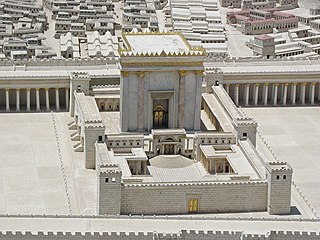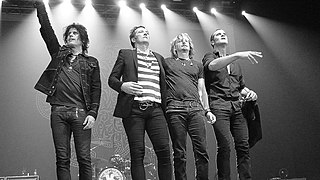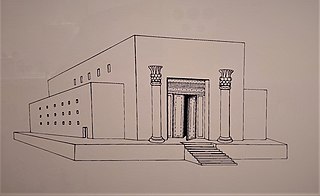
The Temple in Jerusalem, or alternatively the Holy Temple, refers to the two religious structures that served as the central places of worship for Israelites and Jews on the modern-day Temple Mount in the Old City of Jerusalem. According to the Hebrew Bible, the First Temple was built in the 10th century BCE, during the reign of Solomon over the United Kingdom of Israel. It stood until c. 587 BCE, when it was destroyed during the Babylonian siege of Jerusalem. Almost a century later, the First Temple was replaced by the Second Temple, which was built after the Neo-Babylonian Empire was conquered by the Achaemenid Persian Empire. While the Second Temple stood for a longer period of time than the First Temple, it was likewise destroyed during the Roman siege of Jerusalem in 70 CE.

A temple is a place of worship, a building used for spiritual rituals and activities such as prayer and sacrifice. By convention, the specially built places of worship of some religions are commonly called "temple" in English, while those of other religions are not, even though they fulfill very similar functions. The religions for which the terms are used include the great majority of ancient religions that are now extinct, such as the Ancient Egyptian religion and the Ancient Greek religion. Among religions still active: Hinduism, Buddhism, Sikhism, Jainism, Zoroastrianism, the Baháʼí Faith, Taoism, Shinto, Confucianism.

The Second Temple was the reconstructed Temple in Jerusalem, in use between c. 516 BCE and its destruction in 70 CE. In its last phase it was enhanced by Herod the Great, the result being later called Herod's Temple. Defining the Second Temple period, it stood as a pivotal symbol of Jewish identity and was central to Second Temple Judaism; it was the chief place of worship, ritual sacrifice (korban), and communal gathering for Jews. As such, it attracted Jewish pilgrims from distant lands during the Three Pilgrimage Festivals: Passover, Shavuot, and Sukkot.

Stone Temple Pilots is an American rock band formed in San Diego, California, in 1989. Originally consisting of lead vocalist Scott Weiland, guitarist Dean DeLeo, bassist Robert DeLeo, and drummer Eric Kretz, the band's lineup remained unchanged from its formation until the firing of Weiland in February 2013. Vocalist Chester Bennington joined the band in May 2013 but left amicably in November 2015. In 2016, STP launched an online audition for a new lead vocalist; Jeff Gutt was announced as STP's new lead singer on November 14, 2017.

Indiana Jones and the Temple of Doom is a 1984 American action-adventure film directed by Steven Spielberg from a script by Willard Huyck and Gloria Katz, based on a story by George Lucas. It is the second installment in the Indiana Jones film series and a prequel to Raiders of the Lost Ark. The film stars Harrison Ford, who reprises his role as the title character. Kate Capshaw, Amrish Puri, Roshan Seth, Philip Stone, and Ke Huy Quan, in his film debut, star in supporting roles. In the film, after arriving in British India, Indiana Jones is asked by desperate villagers to find a mystical stone and rescue their children from a Thuggee cult practicing child slavery, black magic, and ritual human sacrifice in honor of the goddess Kali.

Mary Temple Grandin is an American academic, inventor, and ethologist. She is a prominent proponent of the humane treatment of livestock for slaughter and the author of more than 60 scientific papers on animal behavior. Grandin is a consultant to the livestock industry, where she offers advice on animal behavior, and is also an autism spokesperson.

International Society for Krishna Consciousness (ISKCON), commonly referred to as the Hare Krishna movement, is a Gaudiya Vaishnava Hindu religious organization. It was founded by A. C. Bhaktivedanta Swami Prabhupada on 13 July 1966 in New York City. ISKCON's main headquarters is in Mayapur, West Bengal, India and it claims approximately 1 million members globally.

Angkor Wat is a Hindu-Buddhist temple complex in Cambodia. Located on a site measuring 162.6 hectares within the ancient Khmer capital city of Angkor, it was originally constructed in 1150 CE as a Hindu temple dedicated to the deity Vishnu. It was later gradually transformed into a Buddhist temple towards the end of the century.

The Peoples Temple Agricultural Project, better known by its informal name "Jonestown", was a remote settlement in Guyana established by the Peoples Temple, an American religious movement under the leadership of Jim Jones. Jonestown became internationally infamous when, on November 18, 1978, a total of 918 people died at the settlement; at the nearby airstrip in Port Kaituma; and at a Temple-run building in Georgetown, Guyana's capital city. The name of the settlement became synonymous with the incidents at those locations.

James Warren Jones was an American cult leader and mass murderer who founded and led the Peoples Temple between 1955 and 1978. In what Jones termed "revolutionary suicide", Jones and the members of his inner circle planned and orchestrated a mass murder-suicide in his remote jungle commune at Jonestown, Guyana, on November 18, 1978. Jones and the events that occurred at Jonestown have had a defining influence on society's perception of cults.

Temple University is a public state-related research university in Philadelphia, Pennsylvania, United States. It was founded in 1884 by the Baptist minister Russell Conwell and his congregation at the Grace Baptist Church of Philadelphia, then called Baptist Temple. Today, Temple is the second-largest university in Pennsylvania by enrollment and awarded 9,128 degrees in the 2023-24 academic year. It has a worldwide alumni base of 378,012, with 352,175 alumni residing in the United States.

Shirley Temple Black was an American actress, singer, dancer, and diplomat, who was Hollywood's number-one box-office draw as a child actress from 1934 to 1938. Later, she was named United States Ambassador to Ghana and Czechoslovakia, and also served as Chief of Protocol of the United States.

A Hindu temple, also known as Mandir(in Sanskrit), Devasthanam(in Konkani and Hindi), Pura(in Balinese), or Kovil(in Tamil), is a sacred place where Hindus worship and show their devotion to deities through worship, sacrifice, and prayers. It is considered the house of the god to whom it is dedicated. Hindu temple architecture, which makes extensive use of squares and circles, has its roots in Vedic traditions, which also influence the temples' construction and symbolism. Through astronomical numbers and particular alignments connected to the temple's location and the relationship between the deity and the worshipper, the temple's design also illustrates the idea of recursion and the equivalency of the macrocosm and the microcosm. A temple incorporates all elements of the Hindu cosmos—presenting the good, the evil and the human, as well as the elements of the Hindu sense of cyclic time and the essence of life—symbolically presenting dharma, artha, kama, moksha, and karma.

The Padmanabhaswamy Temple is a Hindu temple dedicated to Vishnu in Thiruvananthapuram, the capital of the state of Kerala, India. It is one of the 108 Divya Desams which are considered the sacred abodes of Vishnu in the Sri Vaishnava tradition. The name of the city of 'Thiruvananthapuram' in Malayalam and Tamil translates to "The City of Ananta". The temple is built in an intricate fusion of the Kerala style and the Dravidian style of architecture, featuring high walls, and a 16th-century gopuram. While as per some traditions the Ananthapura Temple in Kumbla in Kasaragod district in Kerala is considered as the original spiritual seat of the deity ("Mulasthanam"), architecturally to some extent, the temple is a replica of the Adikesava Perumal Temple in Thiruvattar in Kanyakumari district in Tamil Nadu. It is widely considered the world's richest temple.

The Jagannath Temple is a Hindu temple dedicated to the god Jagannath, a form of Vishnu in Hinduism and two of his siblings, Balaram and Subhadra, alongside Sudarshan. It is located in Puri in the state of Odisha, situated on the eastern coast of India. As per temple records, King Indradyumna of Avanti built the main temple of Jagannath at Puri. The present temple was rebuilt from the eleventh century onwards, on the site of the pre-existing temples in the compound, but not the main Jagannath temple, and begun by Anantavarman Chodaganga, the first king of the Eastern Ganga dynasty. Many of the temple rituals are based on Oddiyana Tantras which are the refined versions of Mahayana Tantras as well as Shabari Tantras which are evolved from Tantric Buddhism and tribal beliefs respectively. The local legends link the idols with aboriginal tribes and the daitapatis (servitors) claim to be descendants of the aboriginals. The temple is one of the 108 Abhimana Kshethram of the Vaishnavite tradition.

Nakkapalle or Nakkapalli is a census town in Anakapalli district in the state of Andhra Pradesh in India.

North Andhra or Uttara Andhra, also known as Kalinga Andhra, is a geographic region in the Indian state of Andhra Pradesh. It is between the Eastern Ghats and the coast of the Bay of Bengal. It comprises six northern districts of the state, Srikakulam, Parvathipuram Manyam, Vizianagaram, Visakhapatnam, half of the Alluri Sitharama Raju district and Anakapalli. Alluri Sitharama Raju district was carved out of Erstwhile Visakhapatnam and East Godavari districts. So, half of the Alluri Sitharamaraju district belongs to North Andhra/ Uttara Andhra and the southern part of this district belongs to Coastal Andhra region/ Godavari region. As of 2011 census of India, the region with six districts has a population of 9,338,177.

The Temple of Artemis or Artemision, also known as the Temple of Diana, was a Greek temple dedicated to an ancient, localised form of the goddess Artemis. It was located in Ephesus. By AD 401 it is believed it had been ruined or destroyed. Only foundations and fragments of the last temple remain at the site.

The Golden Temple (also known as the Harmandir Sāhib, or the Darbār Sāhib, is a gurdwara located in the city of Amritsar, Punjab, India. It is the pre-eminent spiritual site of Sikhism. It is one of the holiest sites in Sikhism, alongside the Gurdwara Darbar Sahib Kartarpur in Kartarpur, and Gurdwara Janam Asthan in Nankana Sahib.

Solomon's Temple, also known as the First Temple, was a biblical Temple in Jerusalem believed to have existed between the 10th and 6th centuries BCE. Its description is largely based on narratives in the Hebrew Bible, in which it was commissioned by biblical king Solomon before being destroyed during the Siege of Jerusalem by Nebuchadnezzar II of the Neo-Babylonian Empire in 587 BCE. No remains of the destroyed temple have ever been found. Most modern scholars agree that the First Temple existed on the Temple Mount in Jerusalem by the time of the Babylonian siege, and there is significant debate among scholars over the date of its construction and the identity of its builder.






















